Your solar oven won't work effectively on cloudy days because clouds scatter and block the direct sunlight needed to generate proper cooking temperatures. While some diffused light penetrates clouds, it's not concentrated enough for your oven's reflector panels to focus the necessary heat. You'll notice temperatures dropping considerably, often from 300°F to 225°F or lower, making cooking times two to three times longer than on clear days. Cloud cover also disrupts heat retention, and even opening the oven door can cause a 25°F temperature drop. Understanding these challenges will help you adapt your solar cooking strategy for various weather conditions.
Solar Energy Basics During Clouds
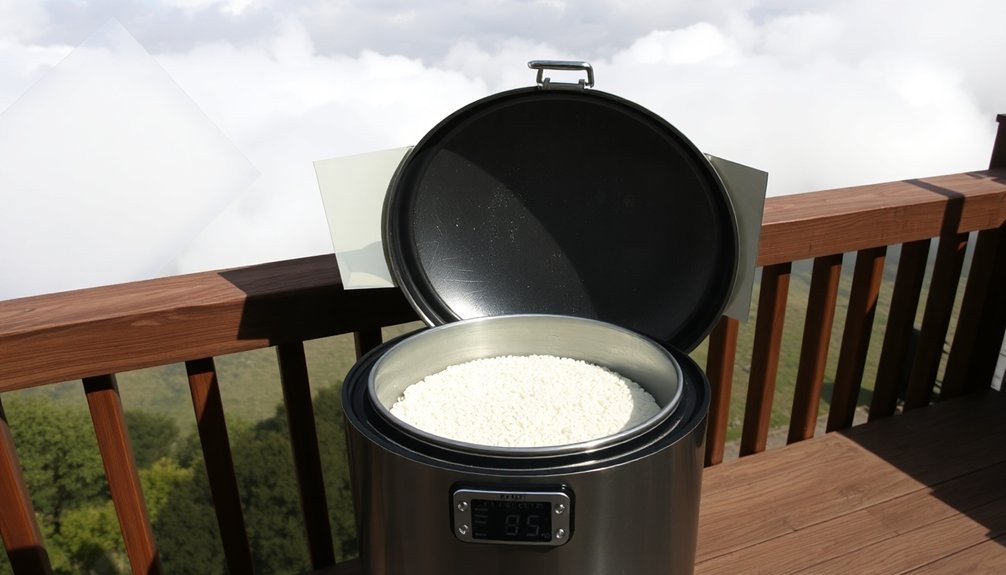
While solar panels can still generate electricity on overcast days, they operate at reduced capacity due to clouds blocking direct sunlight.
Your panels collect diffused light that manages to penetrate through cloud cover, though it's less intense than direct sunlight. That's why you'll notice a decrease in energy production during cloudy conditions.
Modern solar technology has adapted to handle these challenges. If you've installed monocrystalline panels, you'll get better performance in low-light conditions compared to other types. Thin-film panels are particularly effective at capturing diffused sunlight performance.
Features like bypass diodes and micro-inverters help maximize what energy you can collect from the limited available light.
While your solar panels won't produce peak power on cloudy days, they'll still contribute to your energy needs, unlike solar ovens that require direct sunlight to function properly.
Light Diffusion Effects on Cooking
You'll find that clouds scatter sunlight in multiple directions, preventing the concentrated rays needed for solar cooking.
When light diffuses through cloud cover, your solar oven's reflectors can't focus enough energy to generate sufficient cooking temperatures. This principle mirrors how soft diffused light affects photography, dispersing illumination rather than concentrating it.
Without direct sunlight hitting your oven's surfaces, the scattered rays simply won't produce the intense heat required to cook your food effectively.
Scattered Light Reduces Heat
Scattered sunlight dramatically reduces a sun oven's heating power through a simple physics principle: diffused light can't focus effectively on the cooking surface.
When clouds break up sunlight, they prevent the concentrated beam of energy you need for proper solar cooking. Your sun oven relies on direct sunlight to create intense heat on dark surfaces, but cloudy conditions disrupt this process.
Instead of striking your cooking pot directly, the light disperses in multiple directions, greatly weakening its heating ability. Clear skies can help your solar oven reach over 350°F, while on heavily overcast days, you'll notice this effect when clouds move in – your oven's temperature will drop quickly as the scattered light fails to maintain consistent heat levels.
The result? Your cooking times will stretch considerably longer, and on heavily overcast days, you mightn't be able to cook at all.
Cloud Blocks Direct Rays
When clouds move across the sky, they create a barrier that blocks essential direct sunlight from reaching your solar oven. As clouds intercept the sun's rays, they scatter the light in multiple directions, preventing the concentrated beam your cooker needs to function properly.
You'll notice your solar oven's efficiency drops markedly during cloudy conditions because the reflective surfaces can't focus the dispersed light effectively. Without direct rays, the dark cooking pots won't absorb enough solar energy to generate sufficient heat for cooking. Similar to how photographers rely on side lighting placement to create optimal shadows and dimension, direct sunlight is crucial for your solar oven's performance.
Even if you've preheated your oven, cloud cover will disrupt the cooking process by reducing the temperature inside.
While your solar oven might still work under brief, intermittent clouds, continuous overcast conditions will make it impossible to maintain the high temperatures needed for proper cooking.
Temperature Control Challenges
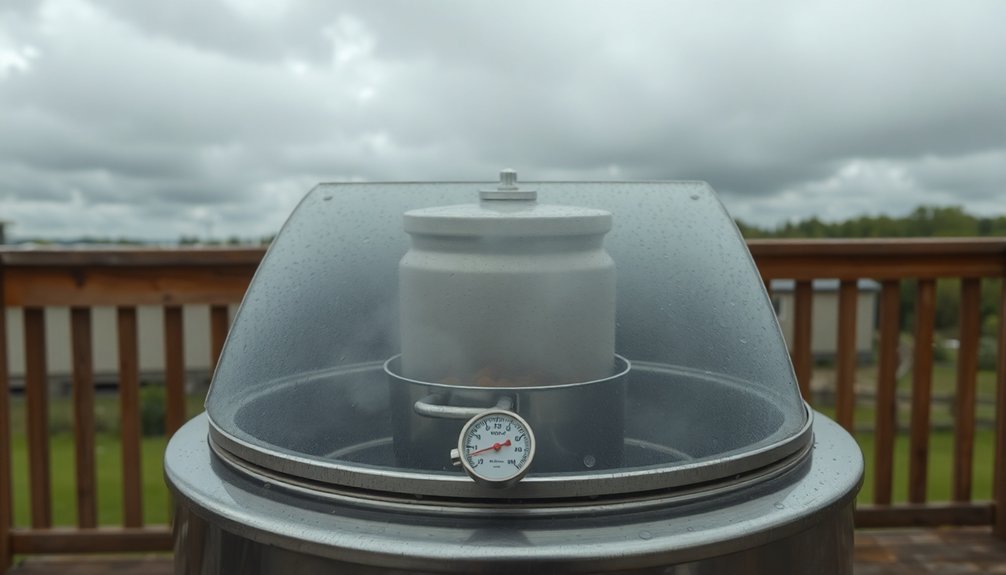
Your sun oven's temperature will drop quickly when clouds pass overhead, causing heat to escape through the same surfaces that were previously absorbing sunlight.
You'll notice erratic temperature gauge readings as clouds move across the sky, making it hard to maintain consistent cooking temperatures.
These unstable conditions create irregular cooking zones within your oven, where some areas may remain hot while others cool rapidly, compromising your food's even cooking.
Heat Loss During Clouds
Because clouds greatly disrupt direct sunlight, solar ovens struggle to maintain consistent cooking temperatures. When clouds block the sun's rays, your oven's heat absorption drops markedly, making it difficult to reach and maintain ideal cooking temperatures.
Your oven's insulation becomes vital during cloudy periods, but even the best materials like crumpled newspaper or fiberglass can't fully compensate for the lack of solar energy.
You'll notice that wind can worsen heat loss, forcing you to make frequent adjustments to capture any available sunlight. The effectiveness of reflective panels and surfaces diminishes dramatically under cloud cover, while your oven's glazing material loses its ability to trap heat efficiently.
Despite using multiple glass panes or enhanced insulation layers, your solar oven simply can't overcome the fundamental problem of reduced solar energy input.
Inconsistent Thermal Readings
Monitoring temperature in a solar oven becomes particularly challenging as clouds create erratic thermal readings throughout the day.
You'll need a reliable Type-K thermocouple thermometer to track these fluctuations accurately, as standard thermometers won't provide the precision needed for cloudy conditions.
Your main temperature monitoring challenges include:
- Continuous temperature shifts due to varying cloud cover, making it difficult to maintain stable cooking conditions.
- Need for real-time monitoring and frequent adjustments to compensate for sudden temperature drops.
- Complexity of integrating weather data with thermal readings to predict and manage temperature changes.
To overcome these issues, you'll need to check readings more frequently on cloudy days and adjust your oven's position accordingly.
Consider using automated tracking systems to help maintain more consistent temperatures despite cloud interference.
Unstable Cooking Zones
While solar ovens can reach high temperatures on clear days, maintaining stable cooking zones becomes nearly impossible during cloudy conditions.
Your oven's effectiveness drops considerably as clouds scatter and reduce solar radiation, making it difficult to maintain consistent cooking temperatures.
You'll notice frequent temperature fluctuations that disrupt your cooking process, as clouds interfere with the vital greenhouse effect inside your oven.
Even with proper insulation materials like crumpled newspaper or fiberglass, you can't trap heat effectively when sunlight is limited.
You'll need to reposition your oven every 30-45 minutes to track the sun, but this effort yields minimal results on overcast days.
Wind, which often accompanies cloudy weather, further compromises your oven's heat retention by disrupting its insulation system.
Cooking Time Adjustments
Since cloud cover considerably reduces solar energy absorption, you'll need to make substantial adjustments to cooking times when using a sun oven on overcast days.
Expect your cooking temperatures to drop from 300°F to around 225°F, which means food will take two to three times longer to cook than on clear days.
- Realign your oven every 30 minutes to track the sun's movement, ensuring you're maximizing available sunlight even through cloud cover.
- Plan your cooking between 10:00 a.m. and 2:00 p.m. when the sun's intensity is highest.
- Use Dutch ovens or cast-iron pots to retain heat longer, and consider cooking without water for better results with meats and vegetables.
Remember that seasonal changes affect cooking times too – you'll have shorter cooking windows in winter months compared to summer's extended daylight hours.
Design Limitations in Cloudy Weather

Your standard solar oven's design relies heavily on direct sunlight to function properly, making it nearly impossible to cook on overcast days.
You'll notice that reflector panels, which normally concentrate sunlight into the cooking chamber, become far less effective when clouds diffuse the sun's rays.
Even well-insulated solar ovens can't maintain sufficient cooking temperatures when their primary energy source is blocked by cloud cover.
Standard Designs Need Sunlight
Standard solar ovens face significant operational challenges during cloudy weather because they rely heavily on direct sunlight to function effectively.
Your solar oven's performance diminishes substantially when clouds block the sun's rays, even with proper insulation and reflective surfaces. You'll notice longer cooking times and lower maximum temperatures on overcast days.
To enhance your solar oven's performance during cloudy conditions:
- Position your oven during peak sunlight hours (11:00 am – 3:00 pm)
- Add thermal mass like rocks or bricks to help retain heat
- Guarantee proper wind protection to maintain consistent temperatures
During winter months, you'll need to make additional adjustments due to lower sun angles and shorter days.
Consider using specialized designs like the Copenhagen Lite, which performs better in low-sun conditions, and maintain proper south-facing positioning for best results.
Reflector Panel Performance Drops
Reflector panels in solar ovens face major performance challenges during cloudy conditions. Your oven's reflective surfaces, typically made of aluminum foil or similar materials, can't effectively concentrate diffused sunlight onto the cooking area.
| Component | Cloud Impact |
|---|---|
| Aluminum Foil | Reduced reflection |
| Mirror Panels | Scattered light |
| Reflective Paint | Limited focusing |
| Panel Angles | Less effective |
| Light Direction | Inconsistent |
You'll notice your solar oven's performance drop considerably as clouds block direct sunlight. While adjusting the panels' tilt might help slightly, it won't overcome the fundamental problem of reduced solar radiation. Even with ideal positioning, your reflectors simply can't gather and concentrate enough energy when sunlight is dispersed by cloud cover. This limitation is inherent to the design and physics of solar cooking.
Heat Retention Problems
While sun ovens can effectively capture solar energy, they face several critical heat retention challenges that can impact their cooking performance.
Heat loss occurs through various mechanisms, primarily through condensation buildup and poor insulation. You'll notice steam collecting on the glass lid, which blocks sunlight and makes it harder to maintain cooking temperatures.
Here are the main heat retention issues you'll encounter:
- Opening the oven door to wipe condensation can drop temperatures by up to 25°, markedly disrupting the cooking process.
- Improperly sealed seams and loose-fitting plexiglass glazing create escape routes for valuable heat.
- Excessive steam buildup requires venting, which forces you to choose between moisture control and heat retention.
To combat these issues, verify proper sealing with aluminum tape and consider using a cloth to absorb excess moisture.
Seasonal Cloud Cover Impact
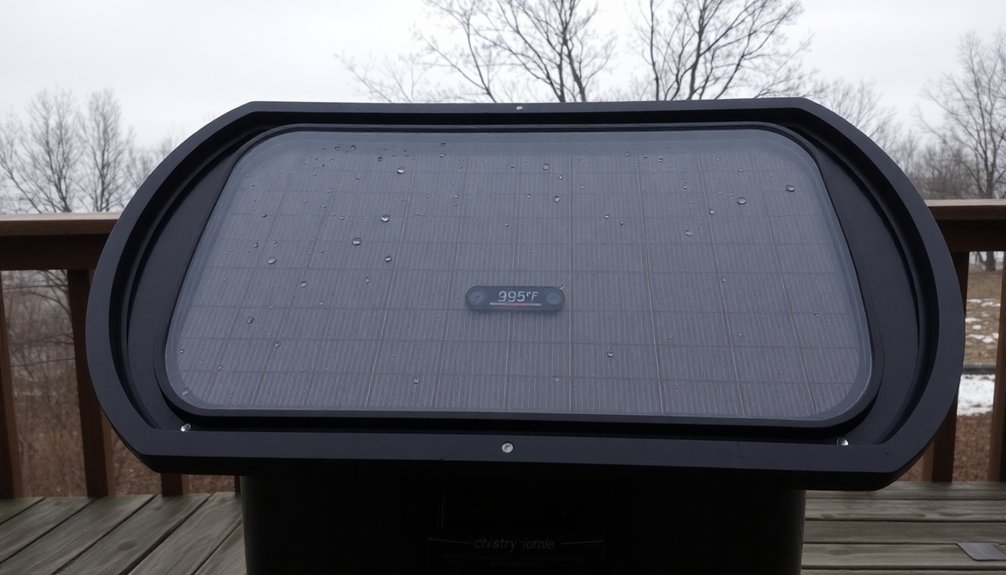
Beyond heat retention challenges, seasonal cloud cover presents a major obstacle for sun oven users.
You'll find that cloud density directly affects your cooking temperature, with thick clouds preventing effective heating altogether. While intermittent clouds slow cooking but don't stop it completely, you'll need to adjust your expectations and timing accordingly.
The seasonal impact becomes particularly noticeable when you consider available sunlight hours. In southern locations, your cooking time drops from 13 hours in June to just 5 hours in December.
You'll need to reposition your oven every 30 minutes to maintain ideal temperatures, which typically range from 300°F to 375°F under cloudy conditions.
To adapt, try using heavier cookware to retain heat and consider preparing slow-cooked meals that can withstand temperature fluctuations throughout the day.
Alternative Cooking Methods
When clouds block your sun oven, several reliable alternatives can keep your outdoor cooking on track.
Rocket stoves offer an efficient solution, burning small amounts of wood while generating intense heat for various cooking methods. You'll also find that steaming and papillote cooking work well in challenging weather, as they rely on moisture retention rather than direct heat.
- Set up a makeshift grill using a metal grate over glowing embers, and use damp wood to control the heat intensity.
- Try canned heat for simple meal preparation, but always cook outdoors to avoid dangerous fumes.
- Create a steam cooking system with a covered pot to maintain consistent heat and moisture.
These alternatives guarantee you can continue cooking effectively, regardless of cloud coverage or weather conditions.
Cloudy Weather Performance Tips

Even with alternative cooking methods at your disposal, you can still optimize your sun oven's performance during cloudy conditions. To maximize efficiency, you'll need to align your oven more frequently and adjust the reflectors to capture whatever sunlight is available.
Use thicker, well-insulated cookware to retain heat longer, and opt for smaller or thinner food portions that'll cook more quickly. You'll find that dark-colored cookware and reflective surfaces help absorb and maintain heat more effectively.
If you're using an advanced design like a vacuum tube model, you'll have better results in cloudy weather.
Keep your oven clean and well-maintained, and monitor temperatures closely as they'll fluctuate more under cloud cover. Remember to plan for longer cooking times and check that all seals are airtight to trap precious heat.
Location and Weather Patterns
Although sun ovens can operate in diverse climates, their effectiveness largely depends on your geographical location and local weather patterns.
You'll get the best results in southern latitudes where sunlight hours are longer, especially during summer months when you can cook for up to 13 hours daily.
Even in extreme cold conditions, your sun oven will work effectively as long as there's sufficient sunlight.
For peak performance, consider these vital factors:
- Sunlight intensity is strongest between 10:00 and 2:00, making this your ideal cooking window.
- You'll need clear skies – while intermittent clouds slow cooking, heavy overcast conditions make cooking impossible.
- Wind conditions matter – secure your oven when winds reach 35 MPH, and verify it's properly staked down.
Your location's altitude and seasonal changes will also affect cooking times and temperature ranges.
Frequently Asked Questions
Can UV Rays Still Power a Solar Oven Through Clouds?
Yes, UV rays can power your solar oven through clouds, but they'll be less effective. You'll find that thin clouds allow up to 80% of UV rays through, while thick clouds considerably reduce cooking efficiency.
Does High Humidity Affect Solar Oven Performance Differently Than Clouds?
Yes, humidity affects your solar oven differently than clouds. While clouds directly block sunlight, reducing power input, high humidity reduces your oven's efficiency by increasing heat loss and slowing the drying process inside.
Will Reflective Snow Coverage Help Compensate for Cloudy Conditions?
No, reflective snow won't help overcome cloudy conditions. While snow can reflect sunlight, you still need direct sunlight for your Sun Oven to work effectively. Clouds block the essential direct rays needed for cooking.
Can Artificial Lighting Be Used to Supplement Cloudy Day Cooking?
You can use artificial lights like high-wattage or infrared lamps to supplement your solar cooking, but they're less efficient than sunlight and aren't practical for everyday use. It's better to use alternative cooking methods.
Do Different Colored Cooking Vessels Perform Better Under Cloudy Conditions?
Yes, you'll find dark-colored vessels perform considerably better under cloudy conditions. They absorb more heat and cook food faster than light-colored ones, which reflect sunlight and reduce cooking efficiency in your solar oven.
In Summary
You'll find that clouds considerably reduce your sun oven's effectiveness by scattering and blocking direct sunlight needed for proper heating. While you can still attempt to use your solar cooker on partly cloudy days, you'll need to extend cooking times and monitor temperatures closely. For best results, plan your solar cooking on clear days or keep traditional cooking methods as a backup when clouds interfere.

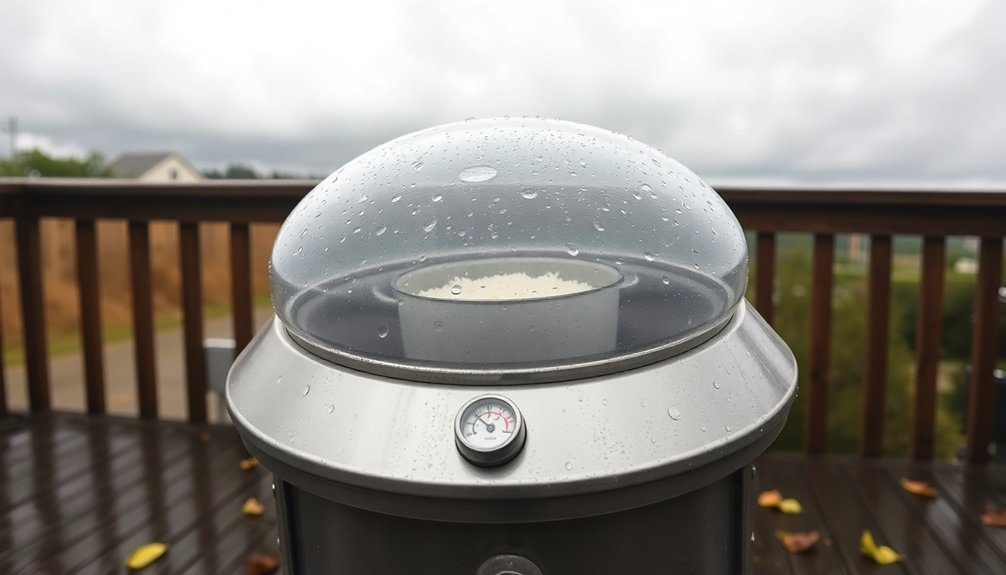
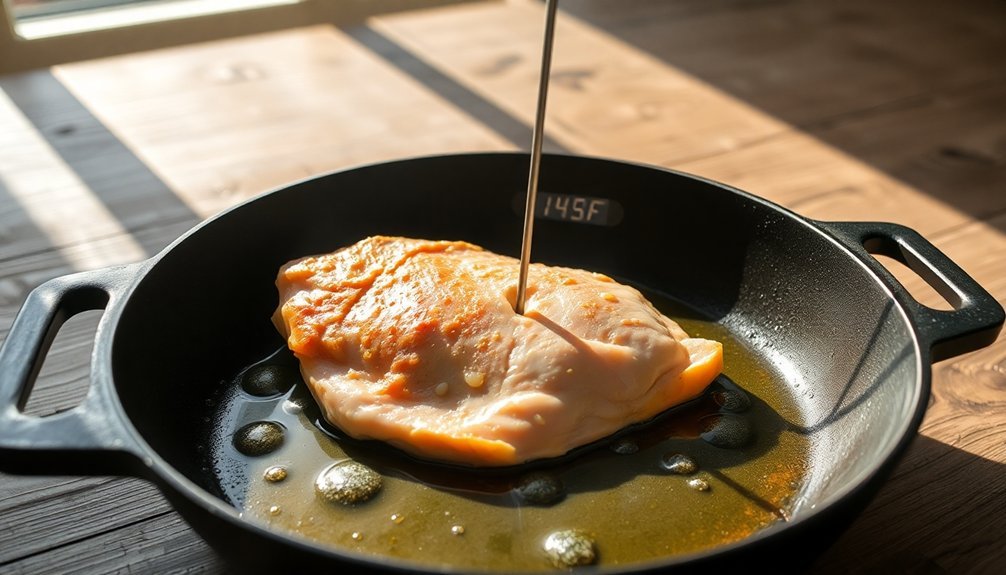
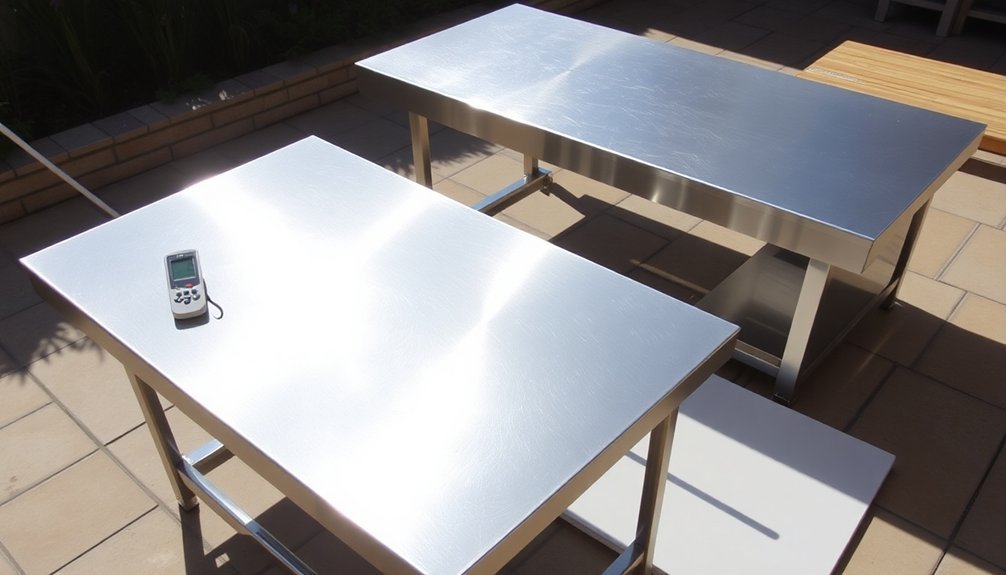
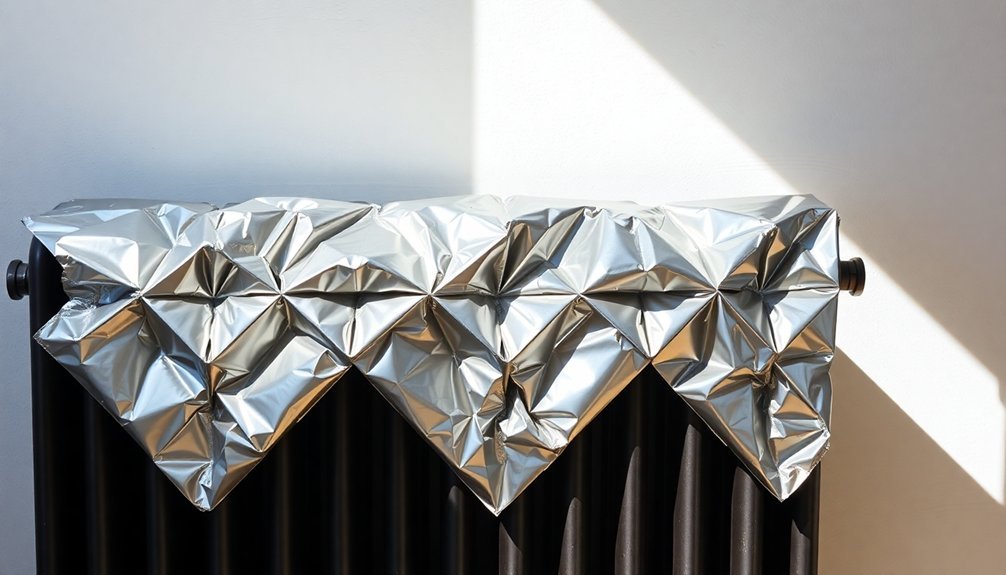
Leave a Reply